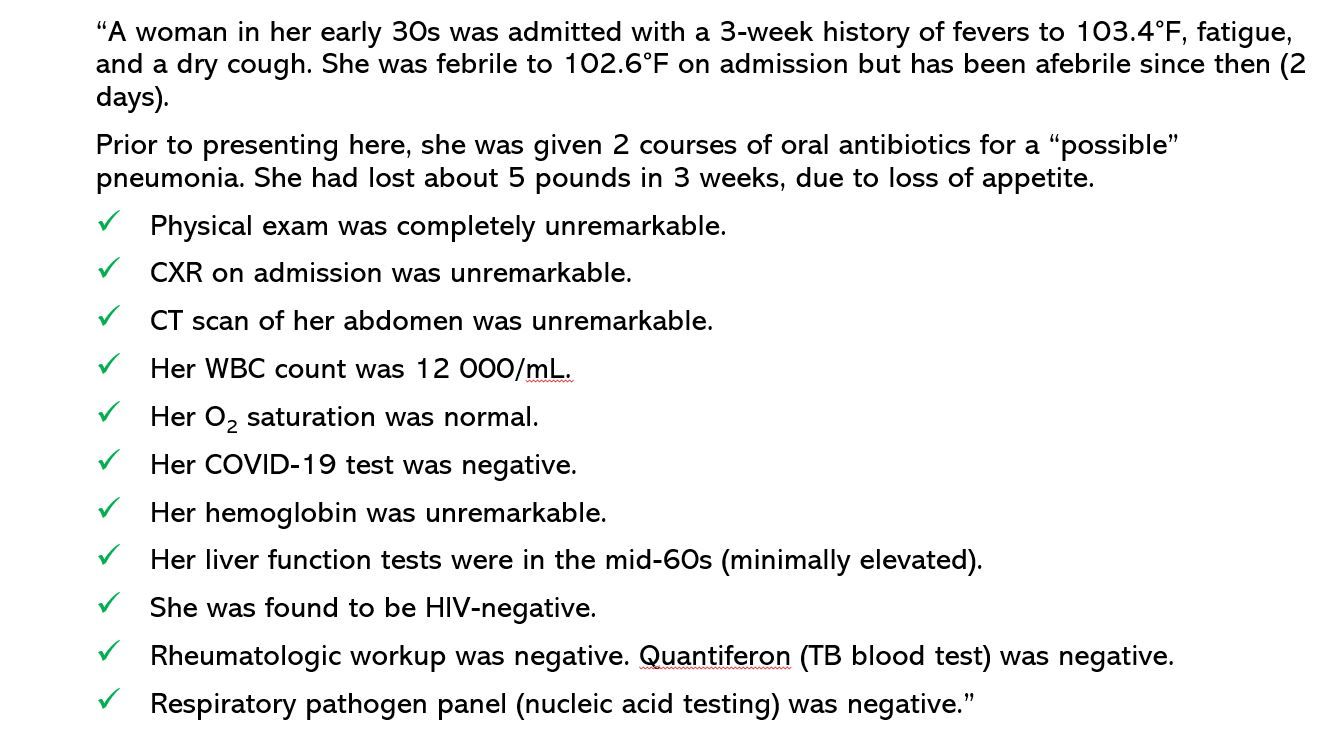- Clinical Technology
- Adult Immunization
- Hepatology
- Pediatric Immunization
- Screening
- Psychiatry
- Allergy
- Women's Health
- Cardiology
- Pediatrics
- Dermatology
- Endocrinology
- Pain Management
- Gastroenterology
- Infectious Disease
- Obesity Medicine
- Rheumatology
- Nephrology
- Neurology
- Pulmonology
A Fever of Unknown Origin: When a Thorough History is an Afterthought
Rodger D MacArthur, MD

At the Medical College of Georgia at Augusta University where I teach, we emphasize to our students the importance of taking a thorough history from their second week of medical school. Most other medical schools do something very similar.
We also introduce the concept of “patterns” and associations, such as right lower quadrant abdominal pain with rebound tenderness suggesting appendicitis, or fever following exposure to rabbits suggesting tularemia. In my experience, students respond well to this approach, better than they do to a more “systematic” approach (eg, malignancy vs infectious vs rheumatologic vs endocrinologic).
But what if no pattern or association is immediately apparent? What if, for instance, a patient presents with a fever of unknown origin (FUO)? Too often, the hospital workup begins with ordering laboratory tests, instead of taking a thorough history. And, too often, laboratory tests do not reveal the diagnosis.
Too often, the hospital workup begins with ordering laboratory tests, instead of taking a thorough history. And, too often, laboratory tests do not reveal the diagnosis.
Two months ago, I was the faculty rounder on a busy infectious diseases (ID) service. It was a Friday afternoon, and as is typical, the ID team began rounds sitting around a table taking turns presenting the new cases. A first-year intern presented the following:

She was started on broad-spectrum antibiotics, directed at her lungs, even though she appeared clinically well (albeit a bit fatigued). I also was told that GI was planning a “blind liver biopsy” on Monday because of her elevated AST and ALT.
Of course, the question to the ID team was, “what does she have?”
No pattern jumped out at me. There were no associations to make, in part, because no one had taken:

Multiple physicians and students had been involved in her care over those 2 to 3 days, with multiple opportunities to ask questions, but no one did. So, we went to her bedside, where she was resting comfortably. Her husband was in a chair next to her. I elicited the following additional information:

Admittedly, determining the etiology of a true fever of unknown origin, which this appeared to be, is challenging. But it is what ID physicians are trained to do, and that training begins in medical school. Furthermore, it has been written that in adults, the etiology of an FUO presenting to a major medical center should be determinable around 90% – 95% of the time. Clearly, the ID team had a job to do; we were all that was standing between her and a blind liver biopsy, and no diagnosis. But what to do?
More laboratory studies? More imaging studies? How about a nuclear medicine scan? Instead, I asked her: “Do you have any unusual pets?” To which she replied, “Like what?” To which I replied, “Like goats.”
Her husband shouted, “What is going on here? A dozen other doctors have seen her, can’t figure out what is going on, and out of nowhere, you ask about goats? Why?”
Her husband shouted, “What is going on here? A dozen other doctors have seen her, can’t figure out what is going on, and out of nowhere, you ask about goats? Why?”
Well, it turns out that her recent trip was to an Airbnb, at which guests were encouraged to play with newborn baby goats. Mama goat had given birth to triplets, one stillborn. Our patient had let the baby goats lick her neck and face. When I asked why, she replied, “because they were so cute.”
Now I had the association I needed: she had acquired brucellosis (sometimes called undulant fever, a classic cause of fever of unknown origin) from the goats. She was very clear: she went to the Airbnb in mid-January, and her fever began on March 8th, well within the typical incubation period of brucella species.
We saw her again the next day. Once again, her husband was at her bedside. He was very proud to tell us that he knew the species of brucella that had infected his wife (Brucella melitensis). In fact, over the course of the evening, he had learned more about brucellosis than most medical students know. And she was excited to learn that she had a rare, but curable, infectious disease, of which only about 100 cases are diagnosed in the US each year (5 or so each year in Georgia).
She encouraged us to use her actual name in any case report or poster/oral presentation. And she told us that she had been convinced that she had cancer and was going to die an early death.
We sent her out on 6 weeks of therapy with the combination of rifampin and doxycycline. I must admit that I did worry that I was anchored to the diagnosis of brucellosis without confirmation. But I was confident that we had correctly diagnosed her.
We saw her in clinic 3 weeks later; she was better, but not “100%.” By then, serology (IgM positive; IgG negative) confirmed the diagnosis of brucellosis. She was complaining of sacroiliac pain (common in brucellosis).
We saw her again 3 weeks later and were delighted to learn that all of her symptoms had resolved. We have submitted her case (without her name) to a national infectious diseases conference. And for fun, I presented it to ID faculty, fellows, residents, and students at one of our recent ID Citywide conferences. No one got the diagnosis correct because no one asked about goat exposure. But I’m sure that they would have if they had been the designated ID faculty rounder.
No one got the diagnosis correct because no one asked about goat exposure.
In the last 2 months, I have thought about this patient a lot. About lessons learned. About the anxiety and fear patients experience when they “know” that something is wrong. About the faith that patients put in their doctors that we will correctly diagnose and cure them. About how I can use this case to teach the next generation of doctors to be thorough and hone their history taking skills.
And I think about her parting comments to me, “I have tremendous confidence in the doctors at this medical center. I have been coming here all my life. And just to let you know, when I have recovered from this infection, I’m going to buy my own baby goat. But I promise that I won’t let the goat lick my face.”
We learn so many lessons as we travel life’s journey. And we, as physicians, are privileged to travel part of it with the patients we treat.
And, finally, a big shoutout to Dr Will Flanary (aka Dr Glaucomflecken) for his insightful video about teaching medical students the importance of taking a history (from an ID perspective).
Dr MacArthur is professor of medicine in the division of infectious diseases and the office of medical affairs at the Medical College of Georgia at Augusta University. He is an NIH-funded researcher and before arriving at the Medical College of Georgia headed the Wayne State University AIDS clinical trial program. He is widely recognized as an authority on the development of antiretroviral treatment. He is a long-time contributor to Patient Care.®
Related Content
